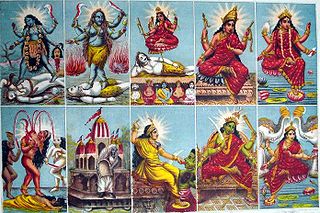
The Mahavidya are a group of ten Hindu Tantric goddesses. The 10 Mahavidyas are usually named in the following sequence: Kali, Tara, Tripura Sundari, Bhuvaneshvari, Bhairavi, Chhinnamasta, Dhumavati, Bagalamukhi, Matangi and Kamala. Nevertheless, the formation of this group encompass divergent and varied religious traditions that include yogini worship, Saivism, Vaishnavism, and Vajrayana Buddhism.

Dhumavati is one of the Mahavidyas, a group of ten Hindu Tantric goddesses. Dhumavati represents the fearsome aspect of Mahadevi, the supreme goddess in Hindu traditions such as Shaktism. She is often portrayed as an old, ugly widow, and is associated with things considered inauspicious and unattractive in Hinduism, such as the crow and the chaturmasya period. The goddess is often depicted carrying a winnowing basket on a horseless chariot or riding a crow, usually in a cremation ground.

Matangi is a Hindu goddess. She is one of the Mahavidyas, ten Tantric goddesses and an aspect of the Hindu Divine Mother. She is considered to be the Tantric form of Saraswati, the goddess of music and learning. Matangi governs speech, music, knowledge and the arts. Her worship is prescribed to acquire supernatural powers, especially gaining control over enemies, attracting people to oneself, acquiring mastery over the arts and gaining supreme knowledge.
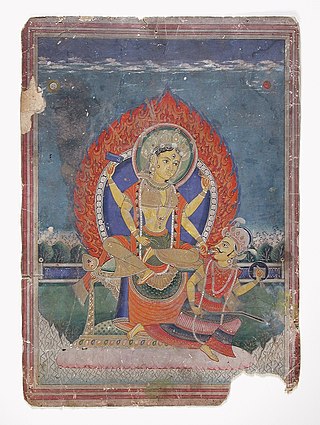
Baglamukhi or Bagalā is the female form of a personification of the mahavidyas, a group of ten Tantrik deities in Hinduism. Devi Bagalamukhi smashes the devotee's misconceptions and delusions with her cudgel. The word "Bagala" is derived from the word "Valga" which, became "Vagla" and then "Bagla". The Devi has 108 different names. Bagalamukhi is commonly known as Pitambari in North India, the goddess associated with yellow color or golden color. She sits on golden throne having pillars decorated with various jewels and has three eyes, that symbolises that she can impart ultimate knowledge to the devotee.
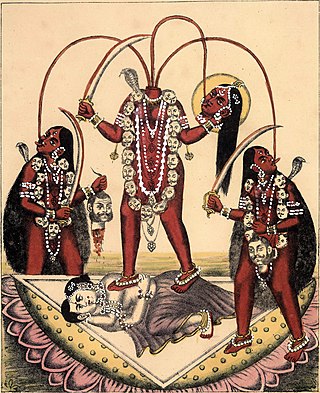
Chhinnamasta, often spelled Chinnamasta, and also called Chhinnamastika and Prachanda Chandika and Jogani Maa, is a Hindu goddess (Devi). She is one of the Mahavidyas, ten goddesses from the esoteric tradition of Tantra, and a ferocious aspect of Mahadevi, the Hindu Mother goddess. The self-decapitated nude goddess, usually standing or seated on a divine copulating couple, holding her own severed head in one hand and a scimitar in another. Three jets of blood spurt out of her bleeding neck and are drunk by her severed head and two attendants.

The Kamakhya Temple at Nilachal hills in Guwahati, Assam is one of the oldest and most revered centres of Tantric practices, dedicated to the goddess Kamakhya. The temple is the center of the Kulachara Tantra Marga and the site of the Ambubachi Mela, an annual festival that celebrates the menstruation of the goddess. Structurally, the temple is dated to the 8th-9th century with many subsequent rebuildings—and the final hybrid architecture defines a local style called Nilachal. It is also one among the oldest 4 of the 51 pithas in the Shakta tradition. An obscure place of worship for much of history it became an important pilgrimage destination, especially for those from Bengal, in the 19th century during colonial rule.

Bhadrakali is a Hindu goddess. She is considered to be the auspicious and fortunate form of Adi Shakti who protects the good, known as bhadra.

Shri Peetambra Peetha is a complex of Hindu temples, located in the city of Datia, in the Madhya Pradesh state of central India. It was, according to many legends 'Tapasthali' of many mythological as well as real life people. The Shivling of shree Vankhandeswar Shiva is tested and approved by the Archaeological Survey of India to be of the same age as that of the Mahabharata. It is primarily a Shaktipeeth place of worship . Many people come here for worship on Saturday, there is the biggest crowd here.

The Bhairabi Temple is located on the outskirts of Tezpur of Sonitpur District in Assam, India.

The Biraja Temple, or Birija Kshetra, is a historic Hindu temple located in Jajpur, Odisha, India. The present temple was built during the 13th century. The principal idol is Devi Durga, who is worshipped as Viraja (Girija), and the temple gave Jajpur the nicknames "Viraja Kshetra" and "Biraja Peetha". The Durga idol has two hands (dwibhuja), spearing the chest of Mahishasura with one hand and pulling his tail with the other. One of her feet is on a lion, and the other is on Mahishasura's chest. Mahishasura is depicted as a water buffalo. The idol's crown features Ganesha, a crescent moon and a lingam. The temple covers a large area, and has several shrines to Shiva and other deities. According to the Skanda Purana it cleanses pilgrims, and it is called the Viraja or the Biraja kshetra. Jajpur is believed to have about one crore of Shiva lingams.

Daksheswar Mahadev or Daksha Mahadev temple is a Hindu temple dedicated to Lord Shiva, located in the town of Kankhal, about 4 km from Haridwar, Uttarakhand, India. It is named after King Daksha Prajapati, the father of Sati. Daksha is one of the fourteen Prajapatis, creator deities, who preside over procreation and are the protector of life in Hindu mythology.
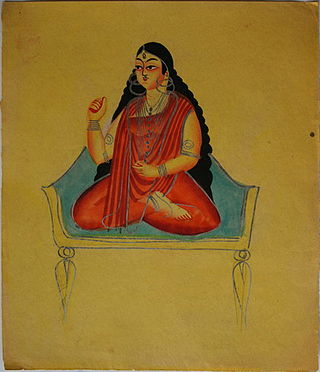
Bhuvaneshvari is a Hindu goddess. She is the fourth amongst the ten Mahavidya goddesses in Shaktism, and one of the highest aspects of Mahadevi. She is identified as Adi Parashakti in the Devi Bhagavata Purana.

Kali Puja, also known as Shyama Puja or Mahanisha Puja, is a festival originating from the Indian subcontinent, dedicated to the Hindu goddess Kali. It is celebrated on the new moon day of the Hindu calendar month of Ashwayuja or Kartika. The festival is especially popular in the region of West Bengal, and other places like Mithila and Anga of Bihar, Jharkhand, Odisha, Assam, and Tripura, as well as the town of Titwala in Maharashtra, along with the neighbouring country of Bangladesh.

Kalijai Temple is located on an island in Chilika Lake. It is considered to be the abode of the Goddess Kalijai. Goddess Kalijai is actually Kali, the source and the first 'Mahavidya' of 'Dasmahavidyas'. Highly revered by the local populace, the deity has been venerated in the local folklores and legends. The island provides an excellent destination for pilgrims as well as tourists. Every year in January, a huge gala fair is held during the festival of Makar Sankranti.

The Goddess Ugratara is the tutelary deity of Eastern Ganga dynasty kings of erstwhile Kalinga dynasty. Her ancient temple lies at Mulajharigarh village, Bhusandapur 65 kilometers from State capital Bhubaneswar, Orissa, India. The icon of Mother Tara is three-eyed and Chaturbhuja, holding potent weapons as sword, dagger, blue lotus and a drinking cup in her hands. She stands over a corpse on burning flames of funeral pyre. Serpent anklets and a serpent on crown are visible which clearly dates back to the time of the 11th-century Tantrik text Sadhanamala Tantra. When later kings of Gajapati dynasty revered goddess Kali or Shyamakaali she had less importance and her worship received less attention. But many people belonging to Vasishtha Gotra revere her as Ishta devi. She is one among ten Mahavidya in Hindu Tantrik theology. She is very popular as Ugratara due to her fierce aspect, but benevolent to the adorers as Ekajata/Neela-Saraswati. Nearby railway station is Bhushandapur in Khordha district which is accessible from Bhubaneswar and Balugaon by local passenger trains. The main festivals here are Chaitra parba, Raja Parba, Sharadiya Durga Puja. She is worshipped in tantrik way and offered all tantrik fivefold paraphrenalias.

Chhinnamastika Temple dedicated to Goddess Chinnamasta is a Hindu pilgrimage centre located in Rajrappa, in Ramgarh district of Jharkhand, India. The place attracts devotees from all parts of Jharkhand, and also from the neighbouring states of West Bengal and Bihar.

Lalita Ghat is one of the main ghats on the Ganges River in Varanasi. The ghat is named after Hindu Goddess Lalita and was built in early 19th century by King of Nepal, Rana Bahadur Shah. The ghat houses the famous Nepali Mandir and Lalita Gauri Mandir.
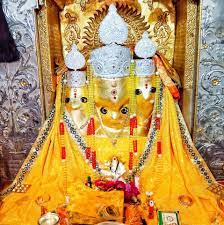
The Bagalamukhi Temple, Nalkheda is located on the banks of the Lakhundar River, a tributary of the Narmada River, in Nalkheda, a town in the Agar Malwa district of Madhya Pradesh, India. It is dedicated to the goddess Bagalamukhi, a devi of the Hindu religion and one of the ten Mahavidyas. She is associated with the colour yellow.

The Bagalamukhi Temple, bankhandi is located on Kangra district of Himachal Pradesh, India. It is dedicated to the goddess Bagalamukhi, a devi of the Hindu religion and one of the ten Mahavidyas. She is associated with the colour yellow. she is also named as peethambara. She sits on golden throne having pillars decorated with various jewels and has three eyes, that symbolises that she can impart ultimate knowledge to the devotee.




















